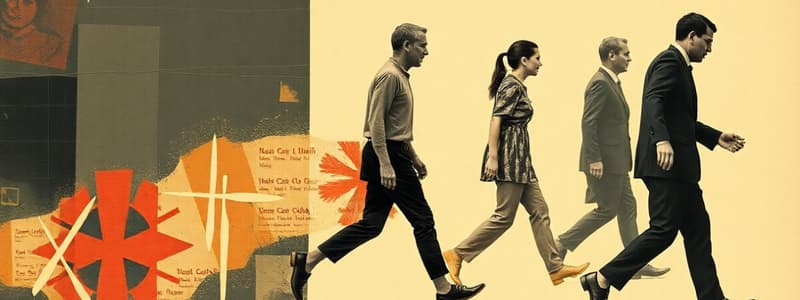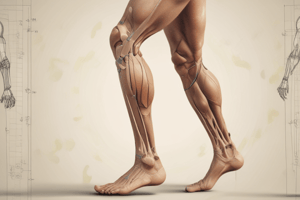Podcast
Questions and Answers
What is the Preferred Transition Speed (PTS) for most people when transitioning from walking to running?
What is the Preferred Transition Speed (PTS) for most people when transitioning from walking to running?
- 1 m/s
- 3 m/s
- 2 m/s (correct)
- 4 m/s
How does increasing walking speed affect ground reaction forces (GRF) during locomotion?
How does increasing walking speed affect ground reaction forces (GRF) during locomotion?
- GRF increases during both loading and propulsion phases.
- GRF increases during the loading phase and decreases during the propulsion phase. (correct)
- GRF decreases during both loading and propulsion phases.
- GRF remains constant regardless of walking speed.
What muscle mechanics differentiate walking from running at higher speeds?
What muscle mechanics differentiate walking from running at higher speeds?
- Running requires greater hip flexion than walking.
- Running does not involve significant knee flexion.
- Muscle activation levels are the same for both activities.
- Walking requires greater plantarflexion torque than running. (correct)
What role does joint kinetics play in the transition to running?
What role does joint kinetics play in the transition to running?
What question did Neptune and Sasaki investigate regarding the muscle mechanics during the walking to running transition?
What question did Neptune and Sasaki investigate regarding the muscle mechanics during the walking to running transition?
What effect does increased walking speed have on plantarflexor force production?
What effect does increased walking speed have on plantarflexor force production?
How does transitioning from walking to running affect plantarflexor force output?
How does transitioning from walking to running affect plantarflexor force output?
Which phase of the running cycle involves both take-off and landing distances?
Which phase of the running cycle involves both take-off and landing distances?
What primarily dictates the duration of the stance phase in running?
What primarily dictates the duration of the stance phase in running?
What happens when foot contact is made in front of the center of mass (CoM) during running?
What happens when foot contact is made in front of the center of mass (CoM) during running?
What does the equation K = Force (Fg,y) / Displacement (y) represent?
What does the equation K = Force (Fg,y) / Displacement (y) represent?
Which aspect does NOT differentiate running from walking?
Which aspect does NOT differentiate running from walking?
How does running improve the mechanical situation for plantarflexors compared to walking?
How does running improve the mechanical situation for plantarflexors compared to walking?
What is the main objective of optimizing spring compression in sprinting?
What is the main objective of optimizing spring compression in sprinting?
Which factor does not contribute to regulating leg stiffness?
Which factor does not contribute to regulating leg stiffness?
What is a drawback of increased leg stiffness during sprinting?
What is a drawback of increased leg stiffness during sprinting?
What effect does increasing stride frequency have on sprinting mechanics?
What effect does increasing stride frequency have on sprinting mechanics?
To achieve maximum sprinting speed, what is crucial about the timing of force application?
To achieve maximum sprinting speed, what is crucial about the timing of force application?
How do larger ground reaction force moments at each joint affect muscle mechanics?
How do larger ground reaction force moments at each joint affect muscle mechanics?
What is the impact of minimizing braking force during a sprint?
What is the impact of minimizing braking force during a sprint?
What happens to the angle of release as speed increases in a sprint?
What happens to the angle of release as speed increases in a sprint?
What is a characteristic of stable coordination patterns in movement?
What is a characteristic of stable coordination patterns in movement?
What do hierarchical models of movement control emphasize?
What do hierarchical models of movement control emphasize?
Which aspect does dynamical system models primarily focus on in movement control?
Which aspect does dynamical system models primarily focus on in movement control?
How do recent models of movement control relate to earlier models?
How do recent models of movement control relate to earlier models?
What drives the switching between coordination patterns during movement?
What drives the switching between coordination patterns during movement?
What is the primary role of arm movement during running?
What is the primary role of arm movement during running?
Which factor is crucial for improving running economy?
Which factor is crucial for improving running economy?
What is a characteristic of distance running as compared to sprinting?
What is a characteristic of distance running as compared to sprinting?
How does dynamical systems theory contribute to our understanding of human movement?
How does dynamical systems theory contribute to our understanding of human movement?
What does the concept of 'attractor' states refer to in the context of movement control?
What does the concept of 'attractor' states refer to in the context of movement control?
What is the significance of transitions between multiple attractor regions in movement control?
What is the significance of transitions between multiple attractor regions in movement control?
Which of the following best describes the role of environmental context in performance according to dynamical systems theory?
Which of the following best describes the role of environmental context in performance according to dynamical systems theory?
How does dynamical systems theory view the role of higher motor centers in movement?
How does dynamical systems theory view the role of higher motor centers in movement?
Flashcards are hidden until you start studying
Study Notes
Walk to Run Transition
- Humans typically transition to a running gait at a speed of approximately 2 m/s or 7.2 km/h, known as the Preferred Transition Speed (PTS).
- The PTS does not coincide with the point where running becomes more energy-efficient than walking.
- As walking speed increases, the ground reaction force (GRF) during the loading phase increases while the GRF during the pre-swing/propulsion phase decreases.
- Increased walking speed also leads to greater posterior GRF and anterior GRF during loading and propulsion phases, respectively.
- The increased muscle activation needed for walking at speeds above the PTS may contribute to the transition to running due to greater ankle dorsiflexion, knee flexion, and hip extension during the swing phase.
Muscle Mechanics in Gait Transition
- Plantarflexor force production becomes more challenging at higher walking speeds.
- Transitioning to running improves the mechanical situation for plantarflexors, increasing force output.
- Both plantarflexors and dorsiflexors experience slightly increased activation and force output during running, but the change in plantarflexor force output is significantly larger.
Running Mechanics
- The running cycle consists of a stance phase and an airborne phase.
- Stride length is influenced by take-off distance, flight distance, and landing distance.
- Stride rate is determined by the time spent in contact with the ground and the time spent in the air.
- Running involves increased joint flexion, greater energy expenditure, and longer strides compared to walking.
Force Application in Running
- Foot contact in front of the center-of-mass (COM) produces a braking force opposing movement.
- Altering foot placement and actively extending the hip minimizes this braking force, increasing COM velocity.
- Sprinting requires maximizing stride frequency, minimizing ground contact time, and increasing leg stiffness.
Leg Stiffness in Running
- Running can be modeled as a spring-mass system, with leg stiffness playing a crucial role in determining stance phase duration, COM vertical displacement, and force application rate.
- High leg stiffness enables rapid force opposition and minimizes force absorption and stance phase duration, but also increases vertical COM displacement.
- Leg stiffness is influenced by joint torques, muscle forces, muscle activity, and the stiffness of elastic soft tissues (muscles, tendons, and connective tissue).
Sprint Mechanics
- Sprinters aim to maximize stride length and stride frequency by utilizing various techniques, such as increasing leg stiffness, minimizing ground contact time, maximizing take-off speed, and reducing landing distance.
- The arms play a role in counteracting the torque created by leg swing, preventing trunk rotation and medio-lateral force generation.
Models of Movement Control
- Dynamical systems theory views human movement as self-organizing based on limb dynamics, predicting the emergence of coordination patterns without specific motor commands.
- The theory suggests that movement variability is beneficial for performance and learning.
- The transition between stable coordination patterns, such as walking and running, is influenced by "control variables," like speed.
Hierarchical Models
- Hierarchical models emphasize the role of the brain in specifying muscle and movement commands, with these commands interacting with and modulating lower reflexes.
- Dynamical systems models focus on the mechanics of the musculoskeletal system and predict that coordinated movement can occur without descending control.
- Recent models of movement control integrate ideas from both hierarchical and dynamical systems approaches.
Studying That Suits You
Use AI to generate personalized quizzes and flashcards to suit your learning preferences.


